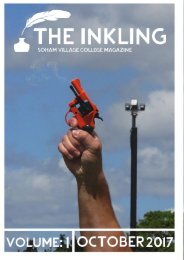The Inkling Volume 3
You also want an ePaper? Increase the reach of your titles
YUMPU automatically turns print PDFs into web optimized ePapers that Google loves.
Mr & Mrs Pride 3<br />
By miss fletcher<br />
us fi gures thr o ug ho u t time that<br />
dy o ur PRI DE va lues.<br />
(1939 - )<br />
an in fashion.”<br />
wish immigrants in <strong>The</strong> Bronx, one of the<br />
ressional districts in the entirety of the<br />
, Ralph Lauren had a tough upbringing.<br />
as a house painter by trade, making<br />
anting more comfortable prospects for<br />
ren’s mother pushed him to become a<br />
er, Lauren was determined to make his<br />
nd had a burgeoning obsession with<br />
orked after school as a stock boy to<br />
ght in to the retail industry, forever<br />
chieving his goal.<br />
ome a businessman, Lauren attended<br />
e, but dropped out after only two years.<br />
ntered the army before becoming a<br />
Brooks Brothers (a luxury clothing<br />
hen attempted to introduce his own<br />
ties, but was repeatedly rejected.<br />
e moved to Beau Brummell Neckwear,<br />
d him to design and sell his own ‘Polo’<br />
their shop. A steady growth in sales,<br />
auren tirelessly delivering his ties to<br />
s, raised his reputation and enabled him<br />
ider brand. He began to design women’s<br />
ear, introducing his now famous Polo<br />
as catapulted to success with the shirt<br />
d his own store… and then another, and<br />
another, until he had as many as 109<br />
the world. Lauren currently ranks as<br />
st man in America.<br />
Amalia Eriksson (1824-1923)<br />
"<strong>The</strong> mother of candy.”<br />
Eriksson was no stranger to isolation and tragedy; at the<br />
age of ten her immediate family were struck down by<br />
cholera and did not survive. Her ill fortune continued: she<br />
gave birth to twins, but one baby was stillborn, and, less<br />
than a week later, her husband died. By the age of 35,<br />
Eriksson was poor and widowed with a young child to<br />
raise.<br />
It was this destitution that led to the discovery of a recipe<br />
that would delight the Swedish people. Her daughter<br />
contracted a dreadful cold, yet money was too scarce to<br />
purchase medicine. Instead, Eriksson bought some<br />
peppermint oil and combined it with vinegar and sugar into<br />
a substance that her daughter would easily consume.<br />
Hoping to emulate cough lozenges, Eriksson got to work<br />
on the mixture. In effect, Eriksson made a candy cane and<br />
her daughter adored the taste. <strong>The</strong> medicinal benefits<br />
were minimal, yet it was clear that money could be made<br />
from this venture.<br />
However, at the time women were not allowed to own<br />
businesses. Unperturbed, Eriksson petitioned the council<br />
and was granted special permission from the mayor to<br />
begin selling her produce. She named the candy Polkagris<br />
as red swirls in the candy cane conjured the image of<br />
dresses swirling in the Polka (a popular dance). <strong>The</strong> shop<br />
was an instant success, with even members of the royal<br />
family visiting to satisfy their sweet tooth. To this day, over<br />
10 million candy canes are handmade in Gränna using<br />
Eriksson’s original method. Despite her traumatic and<br />
difficult life, Eriksson made do with what little she had and<br />
had ended up an incredibly esteemed and wealthy lady by<br />
her death at the age of ninety-nine.




